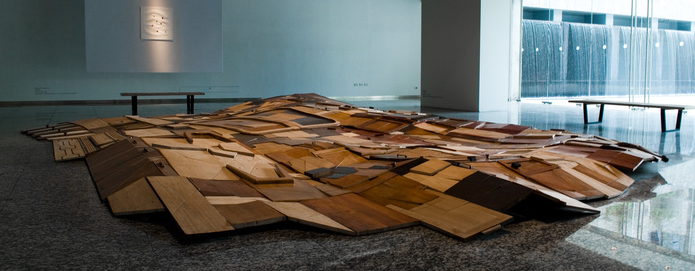Luego de revisar los 215 dossiers que participaron en la convocatoria, escogí 16 artistas, con quienes conversé (tanto de manera presencial en Santiago o por videoconferencia) para conocer más de sus trabajos, expectativas y motivaciones.
Los artistas que visité tienen un muy buen nivel y sus propuestas son muy diversas, así que la escogencia de la terna final no fue fácil, máxime cuando hay tres momentos en este proceso: la exposición en julio de 2013 de los tres artistas chilenos en la Galería Gabriela Mistral en Santiago; la residencia de los tres artistas chilenos (más tres artistas colombianos) en Honda, Colombia en noviembre de 2013; y la exposición de los seis artistas en el Centro Cultural de España en Santiago en 2014.
Cada una de estas instancias implica buscar ciertas características particulares en el trabajo de los artistas: para la primera basta con que sus obras tengan calidad y profundidad; para la segunda es importante que se sientan cómodos trabajando en un lugar desconocido y en un ambiente de residencia; en la tercera, que sean capaces de desarrollar obras a partir de trabajo de campo o de trabajo de archivo. No tuve un tema o argumento curatorial preestablecido en el momento de revisar los dossiers o visitar los artistas, sino que dejé que el análisis de los procesos de los artistas que visité me fuera dictando el camino a seguir.
Tras revisar de nuevo los dossiers, páginas web, y mis notas de trabajo, decidí seleccionar a los siguientes tres artistas:
Claudio Correa (Santiago, Chile, 1972. Vive allí)
Isidora Correa (Santiago, Chile, 1977. Vive allí)
Patricia Domínguez (Santiago, Chile, 1984. Vive en Brooklyn, Estados Unidos)
La exposición, que lleva como título de trabajo Historias del objeto, propone una mirada al artefacto (cotidiano, histórico, natural) como síntoma cultural. Las aproximaciones son múltiples: el objeto en relación con la narración histórica (Claudio Correa); con la vida cotidiana (Isidora Correa); con la construcción de lo natural (Patricia Domínguez). Géneros como la pintura de historia, el paisaje y el bodegón son revisitados desde una perspectiva actual, excavando, socavando y subvirtiendo sus códigos de representación.
—
After studying the 215 portfolios submitted following an open call, I selected 16 artists. I did studio visits with each one of them (in person or via videoconference, from Santiago), to know more about their work and motivations.
All the artists I visited have strong work; their approach is very diverse, so the final selection was not easy, especially considering that there are three moments in this process: an exhibition of the three chosen artists in July 2013 in Santiago; a residency in Honda, Colombia in November 2013 (alongside three Colombian artists); and an exhibition of the six artists at the Centro Cultural de España in Santiago in 2014.
This meant that I had to look for different characteristics in their work: for the first exhibition it was enough to have quality and depth; for the second part of the process, they should feel comfortable working in an unknown place and in a residency mode; for the third part, they should be capable of developing works based on fieldwork or working from archives. I did not have a preestablished curatorial theme when I reviewed the portfolios or when doing studio visits. I opted instead to let the work and the artists’s processes show me the way.
After revising again my notes, portfolios and webpages, I selected the following three artists:
Claudio Correa (Santiago, Chile, 1972. Lives there)
Isidora Correa (Santiago, Chile, 1977. Lives there)
Patricia Domínguez (Santiago, Chile, 1984. Lives in Brooklyn, United States)
The exhibition, which has the working title Stories of the Object, proposes looking at the artifact (quotidian, historic, natural) as a cultural symptom. The approaches are diverse: the object in relation with historical narratives (Claudio Correa); with daily life (Isidora Correa); with the construction of the natural (Patricia Domínguez). Genres such as History painting, Landscape and Still Life are revisited from a contemporary standpoint, excavating, mining and subverting their representational codes.
José Roca, abril de 2013.
